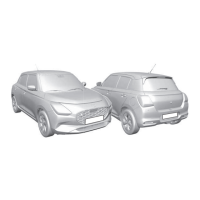5-93
OPERATING YOUR VEHICLE
69TB-01E
– When vehicles ahead are repeatedly
detected and then hidden due to
repeated curves, road dividers or
roadside trees
– When a vehicle ahead approaches
from a far lane
– When a vehicle ahead is far away
– When a vehicle ahead has no lights
– When the lights of a vehicle ahead are
dim
– When a vehicle ahead is reflecting
strong light, such as own headlights
– Situations in which the sensors may
not operate properly: Refer to “Situa-
tions in which the front camera (DSBS
II) and front radar (DSBS II) may not
operate properly” (P.5-64) in this sec-
tion.
• The headlights may change to the low
beams if a vehicle ahead that is using
fog lights without its headlights turned on
is detected.
• House lights, street lights, traffic signals,
and illuminated billboards or signs may
cause the high beams to change to the
low beams, or the low beams to remain
on.
• The following may change the the timing
at which the headlights change to the
low beams:
– The brightness of lights of vehicles
ahead
– The movement and direction of vehi-
cles ahead
– The distance between the vehicle and
a vehicle ahead
– When a vehicle ahead only has lights
illuminated on one side
– When a vehicle ahead is a two-
wheeled vehicle
– The condition of the road (gradient,
curve, condition of the road surface,
etc.)
– The number of passengers and
amount of luggage
• The headlights may change between the
high beams and low beams unexpect-
edly.
• Bicycles and other small vehicles may
not be detected.
• In the following situations, the system
may not be able to correctly detect the
brightness of the surroundings. This may
cause the low beams to remain on or the
high beams to flash or dazzle pedestri-
ans or vehicles ahead. In such a case, it
is necessary to manually change
between the high beams and low
beams.
– When there are lights similar to head-
lights or tail lights in the surrounding
area
– When headlights or tail lights of vehi-
cles ahead are turned off, dirty, chang-
ing color, or not aimed properly
– When the headlights are repeatedly
changing between the high beams
and low beams.
– When use of the high beams is inap-
propriate or when the high beams may
be flashing or dazzling pedestrians or
other drivers.
– When the vehicle is used in an area in
which vehicles travel on the opposite
side of the road of the country for
which the vehicle was designed, for
example using a vehicle designed for
right-hand traffic in a left-hand traffic
area, or vice versa
– When it is necessary to disable the
system: Refer to “When it is necessary
to disable the system” (P.5-59) in this
section.
– Situations in which the sensors may
not operate properly: Refer to “Situa-
tions in which the front camera (DSBS
II) and front radar (DSBS II) may not
operate properly” (P.5-64) in this sec-
tion.
Changing high beam assist setting
The settings of the high beam assist can
be changed through the information dis-
play setting mode. For details, refer to
“Setting mode of information display”
(P.12-8).

